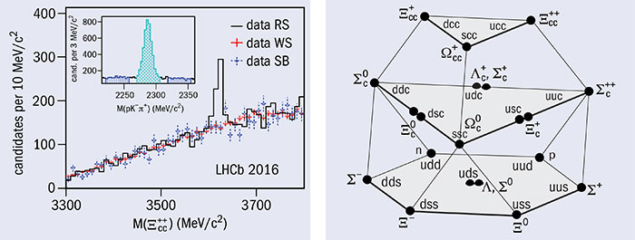
The LHCb collaboration has discovered a new weakly decaying particle: a baryon called the Ξ++cc, which contains two charm quarks and an up quark. The discovery of the new particle, which was observed decaying to the final-state Λ+c K– π+ π+ and is predicted by the Standard Model, was presented at the European Physical Society conference in Venice on 6 July.
Although the quark model of hadrons predicts the existence of doubly heavy baryons – three-quark states that contain two heavy (c or b) quarks – this is the first time that such states have been observed unambiguously with overwhelming statistical significance (well in excess of 5σ with respect to background expectations). The properties of the newly discovered Ξ++cc baryon shed light on a long-standing puzzle surrounding the experimental status of doubly charmed baryons, opening an exciting new branch of investigation for LHCb.
The team scrutinised large high-purity samples of Λ+c → p K– π+ decays in LHC data recorded at 8 and 13 TeV in 2012 and 2016, respectively, and discovered an isolated narrow structure in the Λ+c K– π+ π+ mass spectrum (associating the Λ+c baryon with further particles) at a mass of around 3620 MeV/c2. After eliminating all known potential artificial sources, the collaboration concluded that the highly significant peak is a previously unobserved state. Corroboration that it is the weakly decaying Ξ++cc came from examining a subset of data in which the reconstructed baryons lived for a measurable period before decaying. Such a requirement eliminates all promptly decaying particles, leaving only long-lived ones that are the hallmark of weak transitions.
Although the existence of baryons with valence-quark content ccu and ccd (corresponding to the Ξ++cc and its isospin partner Ξ+cc) is expected, the experimental status of these states has been controversial. In 2002, the SELEX collaboration at Fermilab in the US claimed the first observation of this class of particle by observing a significant peak of about 16 events at a mass of 3519±1 MeV/c2 in the Λ+c K– π+ mass spectrum, which they identified as the closely related state Ξ+cc. Puzzlingly, the short lifetime (which was too small to be measured at SELEX) and the very large production rate of the state seemed not to match theoretical expectations for the Ξ+cc. Despite SELEXʼs confirmation of the observation in a second decay mode, all subsequent searches – including efforts at the FOCUS, BaBar and Belle experiments – failed to find evidence for doubly charmed baryons. That left both theorists and experimentalists awaiting a firm observation by a more powerful heavy-flavour detector such as LHCb. Although the new result from LHCb does not fully resolve the puzzle (with a mass difference of 103±2 MeV/c2, LHCbʼs Ξ++cc and SELEXʼs Ξ+cc seem irreconcilable as isospin partners), the discovery is a crucial step to an empirical understanding of the nature of doubly heavy baryons.







